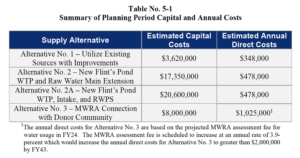The Water Commission voted to stay the course with the current water treatment plant after analyzing a consultant’s report that also examined the pros and cons of building a new plant or applying to join the MWRA system.
The commission will also hold a public forum on its Annual Town Meeting budget requests via Zoom on Tuesday, May 11 at 6:30 p.m. (see below).
In the wake of skyrocketing spending in recent years for modernizing the water treatment plant, which is based on older technology, Tata and Howard presented costs and benefits of three paths forward in a draft report in February:
- Keeping the existing plant and paying for whatever future upgrades it may need
- Building a new and larger plant using current technology that’s better able to cope with current and emerging contaminants
- Decommissioning the plant and applying to get town water from the MWRA
According to the report, a new plant would cost between $17.4 and $20.6 million, while connecting to the MWRA through one of the adjacent member towns would cost $8 million. A new plant would also have to be sited on a separate piece of property since it would have to be built while the current plant is still operating. The land nearby on Sandy Pond Road is town-owned but is conservation land., so using any of that would require finding an equivalent amount of land elsewhere in town to put into conservation to compensate.
Former Conservation Director Thomas Gumbart said he had been approached about taking land out of conservation for municipal service and “strongly warned” that conservation land is not meant to be “a municipal land bank,” Water Commission member Michelle Barnes relayed at the panel’s February 25 meeting.
The likelihood that the MWRA would accept an application from Lincoln is very low, because the town already has an adequate supply of drinking water, and it would be unprecedented for a community to be accepted purely on financial grounds.
Opting for a new plant or joining the MWRA doesn’t make sense at this point because after next year, relatively little money will have to be spent on the current plant, compared to the large amounts of capital investment required for the other two options, Commission Chair Jim Hutchinson said at the group’s April 12 meeting when it voted unanimously to stay with the existing approach.
About $3.62 million must be spent on capital projects between now and 2042 to keep the current plant running, according to the report. A new plant would cost an estimated $478,000 per year to operate and maintain, compared to $348,000 a year for the existing plant and more than $1 million annually if Lincoln went with the MWRA. The MWRA’s annual assessments are slated to rise by 3.9% per year for the next 10 years, Hutchinson noted.
Although sticking with the status quo makes sense for now, the commission may find itself revisiting the MWRA option sometime in the next 20 years when the current treatment plants nears the end of its useful life, Barnes said. The group will redo its analysis every 10 years “as the time approaches to do a major overhaul on the water treatment plan to see if a different decision would make sense in the future,” member Ruth Ann Hendrickson said this week.
One of the concerns about staying with the current plant was whether it would be able to handle the increased levels of TTHM even after the upcoming installation of a new $680,000 coagulation system. Levels have been slowly rising over the years as an indirect result of more organic matter in Flint’s Pond, which may be due to warming temperatures.
The new coagulation system should take care of the problem, but if necessary, the plant could switch to treating the water with a different class of chemicals called chloramines. This would require advance public notification because chloramines must first be removed from water before it can be used in fish tanks and for dialysis.
Budget forum on Tuesday
The Water Department’s budget requests for the coming fiscal year include $1.88 million in operating costs (a 2.5% increase over this year’s total) as well as $907,600 in capital spending, which will necessitate borrowing $830,000 if approved.
The larger of the two capital items is $480,000 to replace the Tower Road well, pump, and piping. During the dry months, the maximum yield of the well (which came online in the 1960s) is limited because of the age, style, and condition of the existing well screen where raw water iron and manganese collect, and cleaning capabilities are limited.

The Water Department’s proposed operating and capital budgets for the fiscal year beginning in July (click image to enlarge).
This year, the Water Commission formally reviewed its budget plans with the Finance Committee and the Capital Planning Committee as the town requested, although it wasn’t required to do so because it is a separate entity funded entirely by user fees. The request came after huge budget increase and borrowing in 2019 and 2020 and staffing for both the department and its overseeing commission were in flux. Former Finance Commission chair Jim Hutchinson was elected to the commission last year and is now the chair.
There will be no increase in water usage rates or base fees next year. Going forward, the commission is “striving to get back to a more ‘steady state’ level of requests for FY23,” Hutchinson said last month, though some capital spending is to be expected every year. In April 2020, water usage rates were hiked by 28% and base charges went up 43% in addition to the borrowing, while the operating budget request rose by 38%.
Click here for the Zoom link for the May 11 forum, or go to the Annual Meeting web page for links to this and other presentations ahead of the May 15 Town Meeting.

Leave a Reply